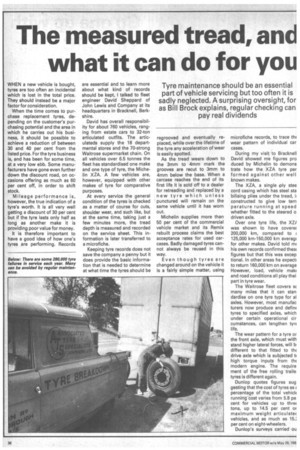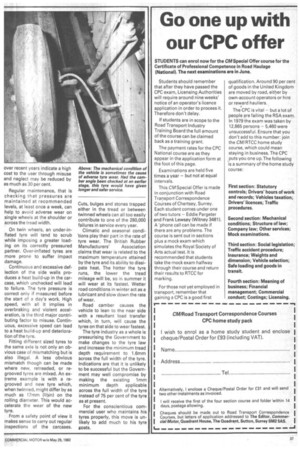The measured tread, and what it can do for you
Page 28

Page 29

If you've noticed an error in this article please click here to report it so we can fix it.
WHEN a new vehicle is bought, tyres are too often an incidental which is lost in the total price. They should instead be a major factor for consideration.
When the time comes to purchase replacement tyres, depending on the customer's purchasing potential and the area in which he carries out his business, it should be possible to achieve a reduction of between 30 and 40 per cent from the listed price. For the tyre business is, and has been for some time, at a very low ebb. Some manufacturers have gone even further down the discount road, on occasions offering as much as 60 per cent off, in order to shift stock.
Mileage performance is, however, the true indication of a tyre's worth. It is all very well getting a discount of 30 per cent but if the tyre lasts only half as long as another make it is providing poor value for money.
It is therefore important to have a good idea of how one's tyres are performing. Records are essential and to learn more about what kind of records should be kept, I talked to fleet engineer David Sheppard of John Lewis and Company at its headquarters in Bracknell, Berkshire.
David has overall responsibility for about 760 vehicles, ranging from estate cars to 32-ton articulated outfits. The articulateds supply the 18 departmental stores and the 70-strong Waitrose supermarket chain. On alt vehicles over 6.5 tonnes the fleet has standardised one make and one type of tyre, the Michelin XZA. A few vehicles are, however, equipped with other makes of tyre for comparative purposes.
At every service the general condition of the tyres is checked as a matter of course for cuts, shoulder wear, and such like, but at the same time, taking just a few minutes more, the tread depth is measured and recorded on the service sheet. This information is later transferred to a microfiche.
Keeping tyre records does not save the company a penny but it does provide the basic information that is needed to determine at what time the tyres should be regrooved and eventually replaced, while over the lifetime of the tyre any acceleration of wear is easily spotted.
As the tread wears down to the 3mm to 4mm mark the grooves are recut to 3rnm to 4mm below the base. When a carcase reaches the end of its first life it is sold off to a dealer for retreading and replaced by a new tyre which unless punctured will remain on the same vehicle until it has worn out.
Michelin supplies more than 50 per cent of the commercial vehicle market and its Remix rebuilt process claims the best acceptance rates for used carcases. Badly damaged tyres cannot always be reused in this way.
Even though tyres are changed around on the vehicle it is a fairly simple matter, using microfiche records, to trace thr wear pattern of individual car cases.
During my visit to Bracknell David showed me figures pro duced by Michelin to demons trate how the XZA tyre per formed against other well known makes.
The XZA, a single ply stee cord casing which has steel sta bilising plies under the tread, constructed to give low tern perature running at speed whether fitted to the steered o driven axle.
Over one tyre life, the XD was shown to have coverer 200,000 km, compared to i 125,000 km-150,000 km averago for other makes. David told mr his own records confirmed thesr figures but that this was excep tional. In other areas he expect: to return 160,000 km on average However, load, vehicle mak( and road conditions all play thei part in tyre wear.
The Waitrose fleet covers sr many miles that it can stan dardise on one tyre type for al axles. However, most manufac turers now produce and defim tyres to specified axles, which under certain operational cir curnstances, can lengthen tyrr life.
The wear pattern for a tyre or the front axle, which must with stand higher lateral forces, will 17,1 different to that fitted to thr drive axle which is subjected ti high torque inputs from thr modern engine. The require ment of the free rolling traile tyres is different again.
Dunlop quotes figures sug gesting that the cost of tyres as ( percentage of the total vehic1( running-cost varies from 5.8 pe cent for vehicles up to thre( tons, up to 14.5 per cent or maximum weight articulate( vehicles, and as much as 15.: per cent on eight-wheelers.
Dunlop's surveys carried ou over recent years indicate a high cost to the user through misuse and neglect may be reduced by as much as 30 per cent.
Regular maintenance, that is checking that pressures are maintained at recommended levels, at least once a week, can help to avoid adverse wear on single wheels at the shoulder or across the tread width.
On twin wheels, an under-inflated tyre will tend to scrub while imposing a greater loading on its correctly pressured partner. Over-inflated tyres are more prone to suffer impact damage.
Continuous and excessive deflection of the side walls produces a heat build-up in the carcase, which unchecked will lead to failure. The tyre pressure is correct only if measured before the start of a day's work. High speed, with all it implies in overbraking and violent acceleration, is the third major contributing factor to misuse. Continuous, excessive speed can lead to a heat build-up and deterioration of the tyre.
Fitting different sized tyres to the same axle is not only an obvious case of mismatching but is also illegal. A less obvious mismatch though can be made where new, retreaded, or regrooved tyres are mixed. An extreme example is with a regrooved and new tyre which, when twinned, might differ by as much as 17mm (2/3in) on the rolling diameter. This would accelerate the wear of the new tyre.
From a safety point of view it makes sense to carry out regular inspections of the carcases. Cuts, bulges and stones trapped either in the tread or between twinned wheels can all too easily contribute to one of the 280,000 failures in service every year.
Climatic and seasonal conditions play their part in the rate of tyre wear. The British Rubber Manufacturers' Association claims that wear is related to the maximum temperature attained by the tyre and its ability to dissi pate heat. The hotter the tyre runs, the lower the tread mileage will be, so in summer it will wear at its fastest. Wetter road conditions in winter act as a lubricant and slow down the rate of wear.
Road camber causes the vehicle to lean to the near side with a resultant load transfer which, in turn, will cause the tyres on that side to wear fastest. The tyre industry as a whole is pressurising the Government to make changes to the tyre law and increase the minimum tread depth requirement to 1.6mm across the full width of the tyre.
Indications are that it is unlikely to be successful but the Govern ment may well compromise by making the existing 1mm minimum depth applicable across the full width of the tyre instead of 75 per cent of the tyre as at present.
For the conscientious commercial user who maintains his tyres properly, this move is unlikely to add much to his lyre posts.
































































